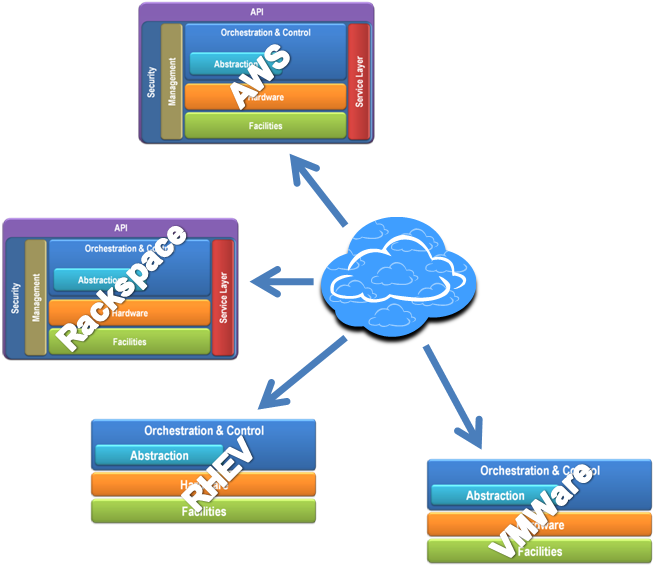RedHat CEO: do not get caught in the "cloud" Vendor Lock-in
 Wikipedia : “Vendor lock-in” (also “proprietary lock-in”, “customer lock-in”, “binding to the supplier”, “closing on one supplier”, “barrier to changing the supplier”), in the economy - consumer dependence from the products and services of one supplier, the inability to change the supplier due to the high costs of transition.
Wikipedia : “Vendor lock-in” (also “proprietary lock-in”, “customer lock-in”, “binding to the supplier”, “closing on one supplier”, “barrier to changing the supplier”), in the economy - consumer dependence from the products and services of one supplier, the inability to change the supplier due to the high costs of transition.Some time ago I tried to talk about the Red Hat cloud strategy . Honestly, it turned out not very. :-) That, in general, it is not surprising, it is difficult to explain everything on several slides, but the main idea is the only phrase: " Red Hat will try to occupy the market, ensuring portability of applications between providers of cloud infrastructure and services. " it is important to read under the cut (the article is slightly shortened and pictures are added for clarity).
What is the main purpose of cloud computing? The original and basic idea of the clouds was to provide as much computing resources as needed here and now, right at the moment. Thus, clouds are simply the ability to quickly and easily increase or decrease computing power.
')
The value of cloud computing lies in the fact that tasks that require huge investments in hardware can now be performed on “leased” equipment, which is much cheaper, since it is not at all necessary that the computing power be owned by the organization that uses them. However, there is a danger that cloud computing will become an attractive target for unscrupulous providers. Will the "efficiency economy" resist the "vendor lock-in" economy? We have to stop and ask ourselves: “Will cloud computing be an example of standardization and freedom of choice, or will it become the next proprietary platform?”
If we don’t want to be locked in the vendor lock-in trap, we must carefully ensure that cloud computing does not become a step backwards in terms of flexibility and choice of solutions for enterprises.
Jim Whitehurst, President and CEO of Red Hat, claims that CIO has a reasonable doubt that with the advent of cloud computing they will receive a wide choice of software and competition among cloud service providers. He believes that the next 24 months will be decisive in determining whether clouds will become an “open standards” area that allows customers to save on resource costs, or they will become a “black box” that benefits only suppliers of closed solutions.
Whitehurst is discouraged by the fact that more and more proprietary cloud offerings are appearing on the market, whose manufacturers implant their own unique, stand-alone cloud products. “It will lead us to a dead end,” says Whitehurst.
Software manufacturers do not think about whether their product is profitable for the customer. They ask themselves: “How to make it so as to make the transition to competitors as difficult as possible?” Whitehurst says. “In fact, customers want to get not proprietary solutions that will drag them into the vendor lock-in trap, but standardized software and the possibility of a wide choice of supplier. Unless, of course, they see innovation in cloud computing, and not a return to the vertical stack times of the 1980s. ”
Cloud computing is indeed more flexible than just software and hardware platforms, but if you find yourself locked in the proprietary software of one vendor, you may not notice any advantages. “Vendor Lock-in will significantly increase the cost and there will not be a significant reduction in funds as a result of increased technical efficiency,” Whitehurst says.
In order to promote cloud computing standardization, Red Hat developed and submitted the Deltacloud project to the Apache Software Foundation open-source. The goal of this project is to provide developers with unified, simplified access to various clouds, such as Amazon, IBM, RackSpace, OpenStack, and Eucalyptus, as well as virtualization technologies, such as ESX (VMware hypervisor).
The idea behind Deltacloud is to adopt one standard API for different cloud environments, which will give developers the opportunity to choose on each of the stack levels. This will make cloud computing more similar to Linux, in the sense that they will be based on uniform standards, and prevent the situation that happened with Microsoft Windows, when everything depends on one company, which receives most of the profit from the ecosystem around it. platforms.

The ability to choose which of the "clouds" will be your applications and data - a necessary property of cloud computing, according to Red Hat
If the Deltacloud project is successful, it will be possible to create applications that can run on a virtual machine, and in the data center, and on private and public clouds, without the need to make changes. Such flexibility and freedom of choice will be an important tool for a modern CIO, whose role has changed dramatically over time.
The set of skills of a modern CIO is connected with an understanding of business strategy and management in a company. Understanding that his work is not only to strengthen IT as a whole, but also to enable users to bring something innovative, apply their IT knowledge, in relation to modern technologies, in order to help users realize their ideas into working solutions.
In this case, avoiding vendor lock-in becomes extremely important. User applications and tools must be mobile both within the enterprise and in cloud computing. It is vital that they are created so that they can be deployed according to user needs, and not the conditions dictated by the supplier.

Deltacloud is central to the Red Hat cloud strategy.
With Deltacloud, Red Hat hopes to demonstrate the speed and power of publicly available technologies for CIO and end users. Deltacloud should open up the possibility of competition and freedom of choice on the cloud market, just as Red Hat Linux has opened it on the hardware market, eliminating the “cost of switching” to a new stack of proprietary offerings. Cloud computing users need to invest in applications that truly benefit them.
“The reason we pay so much attention to this issue is not because Linux is better than Unix; but that we all unexpectedly discovered the spirit of competition and the freedom to choose hardware, ”Whitehurst says. “I can burn software once, and choose among hardware vendors. This leads to tangible savings. In the case of Deltacloud, the same principle applies: write your application once and use it in your private cloud, in your own data center or move it to a public cloud. We do not concern where you want to host your applications, but it’s important for us that you have the opportunity to change your decision and switch to another software or services provider. ”
Vendor lock-in is one of the reasons for high expenses in IT departments, Whitehurst says. With an independent approach to cloud computing, such as Deltacloud, the advantage will be on the side of the company, not the supplier of the "cloud" infrastructure.
Source: https://habr.com/ru/post/134040/
All Articles